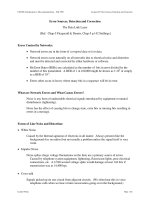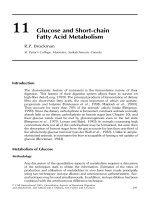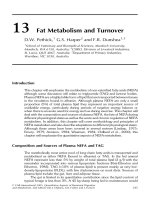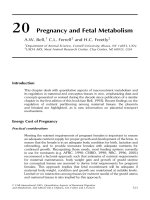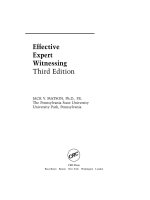Tài liệu Boundary Value Problems, Sixth Edition: and Partial Differential Equations pptx
Bạn đang xem bản rút gọn của tài liệu. Xem và tải ngay bản đầy đủ của tài liệu tại đây (2.45 MB, 515 trang )
BOUNDARY
VALUE PROBLEMS
FIFTH EDITION
This page intentionally left blank
BOUNDARY
VALUE PROBLEMS
AND PARTIAL DIFFERENTIAL EQUATIONS
DAVID L. POWERS
Clarkson University
FIFTH EDITION
Amsterdam Boston Heidelberg London New York Oxford Paris
San Diego San Francisco Singapore Sydney Tokyo
Acquisitions Editor Tom Singe r
Project Manager Jeff Freeland
Marketing Manager Linda Beattie
Cover Design Eric DeCicco
Interior Printer The Maple Vail Book Manufacturing Group
Elsevier Academic Press
30 Corporate Drive, Suite 400, Burlington, MA 01803, USA
525 B Street, Suite 1900, San Diego, California 92101-4495, USA
84 Theobald’s Road, London WC1X 8RR, UK
This book is printed on acid-free paper.
∞
Copyright © 2006, Elsevier Inc. All rights reserved.
No part of this publication may be reproduced or transmitted in any form or by any
means, electronic or mechanical, including photocopy, recording, or any information
storage and retrieval system, without permission in writing from the publisher.
Permissions may be sought directly from Elsevier’s Science & Technology Rights
Department in Oxford, UK: phone: (+44) 1865 843830, fax: (+44) 1865 853333,
e-mail: You may also complete your request on-line via
the Elsevier homepage (), by selecting “Customer Support” and
then “Obtaining Permissions.”
Library of Congress Cataloging-in-Publication Data
Application submitted
British Library Cataloguing in Publication Data
A catalogue record for this book is available from the British Library
ISBN 13: 978-0-12-563738-1
ISBN 10: 0-12-563738-1
For all information on all Elsevier Academic Press publications
visit our Web site at www.books.elsevier.com
Printed in the United States of America
050607080910987654321
Contents
Preface ix
CHAPTER 0 Ordinary Differential Equations 1
0.1 Homogeneous Linear Equations 1
0.2 Nonhomogeneous Linear Equations 14
0.3 Boundary Value Problems 26
0.4 Singular Boundary Value Problems 38
0.5 Green’s Functions 43
Chapter Review 51
Miscellaneous Exercises 51
CHAPTER 1 Fourier Series and Integrals 59
1.1 Periodic Functions and Fourier Series 59
1.2 Arbitrary Period and Half-Range Expansions 64
1.3 Convergence of Fourier Series 73
1.4 Uniform Convergence 79
1.5 Operations on Fourier Series 85
1.6 Mean Error and Convergence in Mean 90
1.7 Proof of Convergence 95
1.8 Numerical Determination of Fourier Coefficients 100
1.9 Fourier Integral 106
1.10 Complex Methods 113
1.11 Applications of Fourier Series and Integrals 117
1.12 Comments and References 124
Chapter Review 125
Miscellaneous Exercises 125
v
vi Contents
CHAPTER 2 The Heat Equation 135
2.1 Derivation and Boundary Conditions 135
2.2 Steady-State Temperatures 143
2.3 Example: Fixed End Temperatures 149
2.4 Example: Insulated Bar 157
2.5 Example: Different Boundary Conditions 163
2.6 Example: Convection 170
2.7 Sturm–Liouville Problems 175
2.8 Expansion in Series of Eigenfunctions 181
2.9 Generalities on the Heat Conduction Problem 184
2.10 Semi-Infinite Rod 188
2.11 Infinite Rod 193
2.12 The Error Function 199
2.13 Comments and References 204
Chapter Review 206
Miscellaneous Exercises 206
CHAPTER 3 The Wave Equation 215
3.1 The Vibrating String 215
3.2 Solution of the Vibrating String Problem 218
3.3 d’Alembert’s Solution 227
3.4 One-Dimensional Wave Equation: Generalities 233
3.5 Estimation of Eigenvalues 236
3.6 Wave Equation in Unbounded Regions 239
3.7 Comments and References 246
Chapter Review 247
Miscellaneous Exercises 247
CHAPTER 4 The Potential Equation 255
4.1 Potential Equation 255
4.2 Potential in a Rectangle 259
4.3 Further Examples for a Rectangle 264
4.4 Potential in Unbounded Regions 270
4.5 Potential in a Disk 275
4.6 Classification and Limitations 280
4.7 Comments and References 283
Chapter Review 285
Miscellaneous Exercises 285
CHAPTER 5 Higher Dimensions and Other Coordinates 295
5.1 Two-Dimensional Wave Equation: Derivation 295
5.2 Three-Dimensional Heat Equation 298
5.3 Two-Dimensional Heat Equation: Solution 303
Contents vii
5.4 Problems in Polar Coordinates 308
5.5 Bessel’s Equation 311
5.6 Temperature in a C ylinder 316
5.7 Vibrations of a Circular Membrane 321
5.8 Some Applications of Bessel Functions 329
5.9 Spherical Coordinates; Legendre Polynomials 335
5.10 Some Applications of Legendre Polynomials 345
5.11 Comments and References 353
Chapter Review 354
Miscellaneous Exercises 354
CHAPTER 6 Laplace Transform 363
6.1 Definition and Elementary Properties 363
6.2 Partial Fractions and Convolutions 369
6.3 Partial Differential Equations 376
6.4 More Difficult Examples 383
6.5 Comments and References 389
Miscellaneous Exercises 389
CHAPTER 7 Numerical Methods 397
7.1 Boundary Value Problems 397
7.2 Heat Problems 403
7.3 Wave Equation 408
7.4 Potential Equation 414
7.5 Two-Dimensional Problems 420
7.6 Comments and References 428
Miscellaneous Exercises 428
Bibliography 433
Appendix: Mathematical References 435
Answers to Odd-Numbered Exercises 441
Index 495
This page intentionally left blank
Preface
This text is designed for a one-semester or two-quarter course in partial dif-
ferential equations given to third- and fourth-year students of engineering and
science. It can also be used as the basis for an introductory course for graduate
students. Mathematical prerequisites have been kept to a minimum — calculus
and differential equations. Vector calculus is used for only one derivation, and
necessary linear algebra is limited to determinants of order two. A reader needs
enough background in physics to follow the derivations of the heat and wave
equations.
The principal objective of the book is solving boundary value problems
involving partial differential equations. Separation of variables receives the
greatest attention because it is widely used in applications and because it pro-
vides a uniform method for solving important cases of the heat, wave, and
potential equations. One technique is not enough, of course. D’Alembert’s so-
lution of the wave equation is developed in parallel with the series solution,
and the distributed-source solution is constructed for the heat equation. In
addition, there are chapters on Laplace transform techniques and on numeri-
cal methods.
The second objective is to tie together the mathematics developed and the
student’s physical intuition. This is accomplished by deriving the mathemati-
cal model in a number of cases, by using physical reasoning in the mathemat-
ical development, by interpreting mathematical results in physical terms, and
by studying the heat, wave, and potential equations separately.
In the service of both objectives, there are many fully worked examples and
now about 900 exercises, including miscellaneous exercises at the end of each
chapter. The level of difficulty ranges from drill and verification of details
to development of new material. Answers to odd-numbered exercises are in
ix
x Preface
the back of the book. An Instructor’s Manual is available both online and in
print (ISBN: 0-12-369435-3), with the answers to the even-numbered prob-
lems. A Student Solutions Manual is available both online and in print (ISBN:
0-12-088586-7), that contains detailed solutions of odd-numbered problems.
There are many ways of choosing and arranging topics from the book to
provide an interesting and meaningful course. The following sections form
the core, requiring at least 14 hours of lecture: Sections 1.1–1.3, 2.1–2.5, 3.1–
3.3, 4.1–4.3, and 4.5. These cover the basics of Fourier series and the solutions
of heat, wave, and potential equations in finite regions. My choice for the next
most important block of material is the Fourier integral and the solution of
problems on unbounded regions: Sections 1.9, 2.10–2.12, 3.6, and 4.4. These
require at least six more lectures.
The tastes of the instructor and the needs of the audience will govern the
choice of further material. A rather theoretical flavor results from including:
Sections 1.4–1.7 on convergence of Fourier series; Sections 2.7–2.9 on Sturm–
Liouville problems, and the sequel, Section 3.4; and the more difficult parts of
Chapter 5, Sections 5.5–5.10 on Bessel functions and Legendre polynomials.
On the other hand, inclusion of numerical methods in Sections 1.8 and 3.5
and Chapter 7 gives a very applied flavor.
Chapter 0 reviews solution techniques and theory of ordinary differential
equations and boundary value problems. Equilibrium forms of the heat and
wave equations are derived also. This material belongs in an elementary differ-
ential equations course and is strictly optional. However, many students have
either forgotten it or never seen it.
For this fifth edition, I have revised in response to students’ changing needs
and abilities. Many sections have been rewritten to improve clarity, provide
extra detail, and make solution processes more explicit. In the optional Chap-
ter 0, free and forced vibrations are major examples for solution of differential
equations with constant coefficients. In Chapter 1, I have returned to deriving
the Fourier integral as a “limit” of Fourier series. New exercises are included
for applications of Fourier series and integrals. Solving potential problems on a
rectangle seems to cause more difficulty than expected. A new section 4.3 gives
more guidance and examples as well as some information about the Poisson
equation. New exercises have been added and old ones revised throughout.
In particular I have included exercises based on engineering research publica-
tions. These provide genuine problems with real data.
A new feature of this edition is a CD with auxiliary materials: animations
of convergence of Fourier series; animations of solutions of the heat and wave
equationsaswellasordinaryinitialvalueproblems;colorgraphicsofsolu-
tions of potential problems; additional exercises in a workbook style; review
questions for each chapter; text material on using a spreadsheet for numerical
methods. All files are readable with just a browser and Adobe Reader, available
without cost.
Preface xi
I wish to acknowledge the skillful work of Cindy Smith, who was the LaTeX
compositor and corrected many of my mistakes, the help of Academic Press
editors and consultants, and the guidance of reviewers for this edition:
Darryl Yong, Harvey Mudd College
Ken Luther, Valparaiso University
Alexander Kirillov, SUNY at Stony Brook
JamesV.Herod,GeorgiaTechUniversity
Hilary Davies, University of Alaska Anchorage
Catherine Crawford, Elmhurst College
Ahmed Mohammed, Ball State University
I also wish to acknowledge the guidance of reviewers for the previous edi-
tion:
Linda Allen, Texas Tech University
Ilya Bakelman, Texas A&M University
Herman Gollwitzer, Drexel University
James Herod, Georgia Institute of Technology
Robert Hunt, Humboldt State University
Mohammad Khavanin, University of North Dakota
Jeff Morgan, Texas A&M University
Jim Mueller, California Polytechnic State University
Ron Perline, Drexel University
William Royalty, University of Idaho
Lawrence Schovanec, Texas Tech University
Al Shenk, University of California at San Diego
Michael Smiley, Iowa State University
Monty Strauss, Texas Tech University
Kathie Yerion, Gonzaga University
David L. Powers
This page intentionally left blank
Ordinary Differential
Equations
CHAPTER
0
0.1 Homogeneous Linear Equations
The subject of most of this book is partial differential equations: their physical
meaning, problems in which they appear, and their solutions. Our principal
solution technique will involve separating a partial differential equation into
ordinary differential equations. Therefore, we begin by reviewing some facts
about ordinary differential equations and their solutions.
We are interested mainly in linear differential equations of first and second
orders, as shown here:
du
dt
=k(t)u + f (t), (1)
d
2
u
dt
2
+k(t)
du
dt
+p(t)u = f (t). (2)
In either equation, if f (t) is 0, the equation is homogeneous.(Anothertest:If
the constant function u(t) ≡0 is a solution, the equation is homogeneous.) In
the rest of this section, we review homogeneous linear equations.
A. First-Order Equations
The most general first-order linear homogeneous equation has the form
du
dt
=k(t)u. (3)
1
2 Chapter 0 Ordinary Differential Equations
This equation can be solved by isolating u on one side and then integrating:
1
u
du
dt
= k(t),
ln |u|=
k(t) dt +C,
u(t) =±e
C
e
k(t) dt
=ce
k(t) dt
. (4)
It is easy to check directly that the last expression is a solution of the differential
equation for any value of c.Thatis,c is an arbitrary constant and can be used
to satisfy an initial condition if one has been specified.
Example.
Solve the homogeneous differential equation
du
dt
=−tu.
The procedure outlined here gives the general solution
u(t) =ce
−t
2
/2
for any c. If an initial condition such as u(0) = 5isspecified,thenc must be
chosen to satisfy it (c =5).
The most common case of this differential equation has k(t) =k constant.
The differential equation and its general solution are
du
dt
=ku, u(t) =ce
kt
. (5)
If k is negative, then u(t) approaches 0 as t increases. If k is positive, then u(t)
increases rapidly in magnitude with t. This kind of exponential growth often
signals disaster in physical situations, as it cannot be sustained indefinitely.
B. Second-Order Equations
It is not possible to give a solution method for the general second-order linear
homogeneous equation,
d
2
u
dt
2
+k(t)
du
dt
+p(t)u = 0. (6)
Nevertheless, we can solve some important cases that we detail in what follows.
The most important point in the general theory is the following.
Chapter 0 Ordinary Differential Equations 3
Principle of Superposition.
If u
1
(t) and u
2
(t) are solutions of the same linear
homogeneous equation (6), then so is any linear combination of them: u(t) =
c
1
u
1
(t) +c
2
u
2
(t).
This theorem, which is very easy to prove, merits the name of principle be-
cause it applies, with only superficial changes, to many other kinds of linear,
homogeneous equations. Later, we will be using the same principle on partial
differential equations. To be able to satisfy an unrestricted initial condition, we
need two linearly independent solutions of a second-order equation. Two so-
lutions are linearly independent on an interval if the only linear combination of
them (with constant coefficients) that is identically 0 is the combination with 0
for its coefficients. There is an alternative test: Two solutions of the same linear
homogeneous equation (6) are independent on an interval if and only if their
Wronskian
W(u
1
, u
2
) =
u
1
(t) u
2
(t)
u
1
(t) u
2
(t)
(7)
is nonzero on that interval.
If we have two independent solutions u
1
(t), u
2
(t) of a linear second-order
homogeneous equation, then the linear combination u(t) = c
1
u
1
(t) +c
2
u
2
(t)
is a general solution of the equation: Given any initial conditions, c
1
and c
2
can
be chosen so that u(t) satisfies them.
1. Constant coefficients
The most important type of second-order linear differential equation that can
be solved in closed form is the one with constant coefficients,
d
2
u
dt
2
+k
du
dt
+pu =0 (k, p are constants). (8)
There is always at least one solution of the form u(t) = e
mt
for an appropriate
constant m.Tofindm, substitute the proposed solution into the differential
equation, obtaining
m
2
e
mt
+kme
mt
+pe
mt
=0,
or
m
2
+km + p =0(9)
(since e
mt
is never 0). This is called the characteristic equation of the differ-
ential equation (8). There are three cases for the roots of the characteristic
equation (9), which determine the nature of the general solution of Eq. (8).
These are summarized in Table 1.
This method of assuming an exponential form for the solution works for
linear homogeneous equations of any order with constant coefficients. In all
4 Chapter 0 Ordinary Differential Equations
Roots of Characteristic General Solution of Differential
Equation Equation
Real, distinct: m
1
=m
2
u(t) =c
1
e
m
1
t
+c
2
e
m
2
t
Real, double: m
1
=m
2
u(t) =c
1
e
m
1
t
+c
2
te
m
1
t
Conjugate complex: u(t) = c
1
e
αt
cos(βt) +c
2
e
αt
sin(βt)
m
1
=α +iβ,m
2
=α −iβ
Tab le 1 Solutions of
d
2
u
dt
2
+k
du
dt
+pu = 0
cases, a pair of complex conjugate roots m = α ±iβ leads to a pair of complex
solutions
e
αt
e
iβt
, e
αt
e
−iβt
(10)
that can be traded for the pair of real solutions
e
αt
cos(βt), e
αt
sin(βt). (11)
We include two important examples. First, consider the differential equation
d
2
u
dt
2
+λ
2
u =0, (12)
where λ is constant. The characteristic equation is m
2
+ λ
2
= 0, with roots
m =±iλ. The third case of Table 1 applies if λ = 0; the general solution of the
differential equation is
u(t) =c
1
cos(λt) + c
2
sin(λt). (13)
Second, consider the similar differential equation
d
2
u
dt
2
−λ
2
u =0. (14)
The characteristic equation now is m
2
−λ
2
= 0, with roots m =±λ.Ifλ =0,
the first case of Table 1 applies, and the general solution is
u(t) =c
1
e
λt
+c
2
e
−λt
. (15)
It is sometimes helpful to write the solution in another form. The hyperbolic
sine and cosine are defined by
sinh(A) =
1
2
e
A
−e
−A
, cosh(A) =
1
2
e
A
+e
−A
. (16)
Thus, sinh(λt) and cosh(λt) are linear combinations of e
λt
and e
−λt
.Bythe
Principle of Superposition, they too are solutions of Eq. (14). The Wronskian
Chapter 0 Ordinary Differential Equations 5
Figure 1 Mass–spring–damper system.
test shows them to be independent. Therefore, we may equally well write
u(t) =c
1
cosh(λt) +c
2
sinh(λt)
as the general solution of Eq. (14), where c
1
and c
2
are arbitrary constants.
Example: Mass–Spring–Damper System.
The displacement of a mass in a mass–spring–damper system (Fig. 1) is de-
scribed by the initial value problem
d
2
u
dt
2
+b
du
dt
+ω
2
u =0,
u(0) =u
0
du
dt
(0) =v
0
.
The equation is derived from Newton’s second law. Coefficients b and ω
2
are proportional to characteristic constants of the damper and the spring, re-
spectively. The characteristic equation of the differential equation is
m
2
+bm + ω
2
=0,
with roots
−b ±
√
b
2
−4ω
2
2
=−
b
2
±
b
2
2
−ω
2
.
The nature of the solution, and therefore the motion of the mass, is determined
by the relation between b/2andω.
b =0: undamped. The roots are ±iω andthegeneralsolutionofthediffer-
ential equation is
u(t) =c
1
cos(ωt) +c
2
sin(ωt).
The mass oscillates forever.
6 Chapter 0 Ordinary Differential Equations
0 < b/2 <ω: underdamped. Therootsarecomplexconjugatesα ±iβ with
α =−b/2, β =
ω
2
−(b/2)
2
.Thegeneralsolutionofthedifferentialequa-
tion is
u(t) =e
−bt/2
c
1
cos(βt) +c
2
sin(βt)
.
The mass oscillates, but approaches equilibrium as t increases.
b/2 = ω: critically damped. Therootsarebothequaltob/2. The general
solution of the differential equation is
u(t) =e
−bt/2
(c
1
+c
2
t).
The mass approaches equilibrium as t increases and may pass through equi-
librium (u(t) may change sign) at most once.
b/2 >ω: overdamped. Both roots of the characteristic equation are real,
say, m
1
and m
2
.Thegeneralsolutionofthedifferentialequationis
u(t) =c
1
e
m
1
t
+c
2
e
m
2
t
.
The mass approaches equilibrium as t increases, and u(t) may change sign at
most once. These cases are illustrated on the CD.
2. Cauchy–Euler equation
One of the few equations with variable coefficients that can be solved in com-
plete generality is the Cauchy–Euler equation:
t
2
d
2
u
dt
2
+kt
du
dt
+pu =0. (17)
The distinguishing feature of this equation is that the coefficient of the nth
derivative is the nth power of t, multiplied by a constant. The style of solution
for this equation is quite similar to the preceding: Assume that a solution has
the form u(t) = t
m
,andthenfindm. Substituting u in this form into Eq. (17)
leads to
t
2
m(m −1)t
m−2
+ktmt
m−1
+pt
m
=0, or
m(m −1) +km + p =0 (k, p are constants). (18)
This is the characteristic equation for Eq. (17), and the nature of its roots de-
termines the solution, as summarized in Table 2.
One important example of the Cauchy–Euler equation is
t
2
d
2
u
dt
2
+t
du
dt
−λ
2
u =0, (19)
Chapter 0 Ordinary Differential Equations 7
Roots of Characteristic General Solution of Differential
Equation Equation
Real, distinct roots: m
1
=m
2
u(t) =c
1
t
m
1
+c
2
t
m
2
Real, double root: m
1
=m
2
u(t) =c
1
t
m
1
+c
2
(ln t)t
m
1
Conjugate complex roots: u(t) =c
1
t
α
cos(β ln t) +c
2
t
α
sin(β ln t)
m
1
=α +iβ,m
2
=α −iβ
Tab le 2 Solutions of t
2
d
2
u
dt
2
+kt
du
dt
+pu = 0
where λ>0. The characteristic equation is m(m −1) +m −λ
2
=m
2
−λ
2
=0.
The roots are m =±λ, so the first case of Table 2 applies, and
u(t) =c
1
t
λ
+c
2
t
−λ
(20)
is the general solution of Eq. (19).
Forthegenerallinearequation
d
2
u
dt
2
+k(t)
du
dt
+p(t)u = 0,
any point where k(t) or p(t) fails to be continuous is a singular point of the
differential equation. At such a point, solutions may break down in various
ways.However,ift
0
is a singular point where both of the functions
(t −t
0
)k(t) and (t −t
0
)
2
p(t) (21)
have Taylor series expansions, then t
0
is called a regular singular point.The
Cauchy–Euler equation is an example of an important differential equation
having a regular singular point (at t
0
= 0). The behavior of its solution near
that point provides a model for more general equations.
3. Other equations
Other second-order equations may be solved by power series, by change of
variable to a kind already solved, or by sheer luck. For example, the equation
t
4
d
2
u
dt
2
+λ
2
u =0, (22)
which occurs in the theory of beams, can be solved by the change of variables
t =
1
z
, u(t) =
1
z
v(z).
8 Chapter 0 Ordinary Differential Equations
Here are the details. The second derivative of u has to be replaced by its ex-
pression in terms of v, using the chain rule. Start by finding
du
dt
=
d
dz
v
z
·
dz
dt
.
Since t =1/z,alsoz =1/t,anddz/dt =−1/t
2
=−z
2
.Thus
du
dt
=−z
2
zv
−v
z
2
=−zv
+v.
Similarly we find the second derivative
d
2
u
dt
2
=
d
dz
du
dt
dz
dt
=
d
dz
(−zv
+v)
−z
2
=−z
2
(−zv
−v
+v
) =z
3
v
.
Finally, replace both terms of the differential equation:
1
z
4
z
3
v
+λ
2
v
z
=0,
or
v
+λ
2
v = 0.
This equation is easily solved, and the solution of the original is then found by
reversing the change of variables:
u(t) =t
c
1
cos(λ/t) +c
2
sin(λ/t)
. (23)
C. Second Independent Solution
Although it is not generally possible to solve a second-order linear homoge-
neous equation with variable coefficients, we can always find a second inde-
pendent solution if one solution is known. This method is called reduction of
order.
Suppose u
1
(t) is a solution of the general equation
d
2
u
dt
2
+k(t)
du
dt
+p(t)u = 0. (24)
Assume that u
2
(t) = v(t)u
1
(t) is a solution. We wish to find v(t) so that u
2
is indeed a solution. However, v(t) must not be constant, as that would not
supply an independent solution. A straightforward substitution of u
2
= vu
1
into the differential equation leads to
v
u
1
+2v
u
1
+vu
1
+k(t)(v
u
1
+vu
1
) +p(t)vu
1
=0.
Chapter 0 Ordinary Differential Equations 9
Now collect terms in the derivatives of v. The preceding equation becomes
u
1
v
+
2u
1
+k(t)u
1
v
+
u
1
+k(t)u
1
+p(t)u
1
v = 0.
However, u
1
is a solution of Eq. (24), so the coefficient of v is 0. This leaves
u
1
v
+
2u
1
+k(t)u
1
v
=0, (25)
which is a first-order linear equation for v
. Thus, a nonconstant v can be
found, at least in terms of some integrals.
Example.
Consider the equation
1 −t
2
u
−2tu
+2u =0, −1 < t < 1,
which has u
1
(t) =t as a solution. By assuming that u
2
=v ·t and substituting,
we obtain
1 −t
2
(v
t +2v
) −2t(v
t +v) +2vt =0.
After collecting terms, we have
1 −t
2
tv
+(2 − 4t
2
)v
=0.
From here, it is fairly easy to find
v
v
=
4t
2
−2
t(1 −t
2
)
=
−2
t
+
1
1 −t
−
1
1 +t
(using partial fractions), and then
ln v
=−2ln(t) −ln(1 − t) −ln(1 +t).
Finally, each side is exponentiated to obtain
v
=
1
t
2
(1 −t
2
)
=
1
t
2
+
1/2
1 −t
+
1/2
1 +t
,
v =−
1
t
+
1
2
ln
1 +t
1 −t
.
D. Higher-Order Equations
Linear homogeneous equations of order higher than 2 — especially order 4 —
occur frequently in elasticity and fluid mechanics. A general, nth-order homo-
geneous linear equation may be written
u
(n)
+k
1
(t)u
(n−1)
+···+k
n−1
(t)u
(1)
+k
n
(t)u =0, (26)
10 Chapter 0 Ordinary Differential Equations
Root Multiplicity Contribution
m (real) 1 ce
mt
m (real) k (c
1
+c
2
t +···+c
k
t
k−1
)e
mt
m, m (complex) 1 (acos(βt) +b sin(βt))e
αt
m = α +iβ
m,
m (complex) k
(a
1
+a
2
t +···+a
k
t
k−1
) cos(βt)e
αt
+(b
1
+b
2
t +···+b
k
t
k−1
) sin(βt)e
αt
Tab le 3 Contributions to general solution
in which the coefficients k
1
(t), k
2
(t), etc., are given functions of t.Thetech-
niques of solution are analogous to those for second-order equations. In par-
ticular, they depend on the Principle of Superposition, which remains valid
for this equation. That principle allows us to say that the general solution
of Eq. (26) has the form of a linear combination of n independent solutions
u
1
(t), u
2
(t), ,u
n
(t) with arbitrary constant coefficients,
u(t) =c
1
u
1
(t) +c
2
u
2
(t) +···+c
n
u
n
(t).
Of course, we cannot solve the general nth-order equation (26), but we can
indeed solve any homogeneous linear equation with constant coefficients,
u
(n)
+k
1
u
(n−1)
+···+k
n−1
u
(1)
+k
n
u =0. (27)
We must now find n independent solutions of this equation. As in the second-
order case, we assume that a solution has the form u(t) = e
mt
,andfindvalues
of m for which this is true. That is, we substitute e
mt
for u in the differen-
tial equation (27) and divide out the common factor of e
mt
. The result is the
polynomial equation
m
n
+k
1
m
n−1
+···+k
n−1
m +k
n
=0, (28)
called the characteristic equation of the differential equation (27).
Each distinct root of the characteristic equation contributes as many inde-
pendent solutions as its multiplicity, which might be as high as n.Recallalso
that the polynomial equation (28) may have complex roots, which will occur
in conjugate pairs if — as we assume — the coefficients k
1
, k
2
, etc., are real.
When this happens, we prefer to have real solutions, in the form of an expo-
nential times sine or cosine, instead of complex exponentials. The contribution
of each root or pair of conjugate roots of Eq. (28) is summarized in Table 3.
Since the sum of the multiplicities of the roots of Eq. (28) is n, the sum of the
contributions produces a solution with n terms, which can be shown to be the
general solution.
Chapter 0 Ordinary Differential Equations 11
Example.
Find the general solution of this fourth-order equation
u
(4)
+3u
(2)
−4u =0.
The characteristic equation is m
4
+3m
2
−4 = 0, which is easy to solve because
it is a biquadratic. We find that m
2
=−4 or 1, and thus the roots are m =±2i,
±1, all with multiplicity 1. From Table 3 we find that a cos(2t) +b sin(2t) cor-
responds to the complex conjugate pair, m =±2i,whilee
t
and e
−t
correspond
to m =1andm =−1. Thus we build up the general solution,
u(t) =a cos(2t) + bsin(2t) +c
1
e
t
+c
2
e
−t
.
Example.
Find the general solution of the fourth-order equation
u
(4)
−2u
(2)
+u =0.
The characteristic equation is m
4
−2m
2
+1 =0, whose roots, found as in the
preceding, are ±1, both with multiplicity 2. From Table 3 we find that each of
the roots contributes a first-degree polynomial times an exponential. Thus, we
assemble the general solution as
u(t) =(c
1
+c
2
t)e
t
+(c
3
+c
4
t)e
−t
.
With sinh(t) =(e
t
− e
−t
)/2 and cosh(t) = (e
t
+ e
−t
)/2, the terms of the pre-
ceding combination can be rearranged to give the general solution in a differ-
ent form,
u(t) =(C
1
+C
2
t) cosh(t) +(C
3
+C
4
t) sinh(t).
Some important equations and their solutions.
1.
du
dt
=ku (k is constant),
u(t) =ce
kt
.
2.
d
2
u
dt
2
+λ
2
u =0,
u(t) =a cos(λt) + bsin(λt).
3.
d
2
u
dt
2
−λ
2
u =0,
u(t) =a cosh(λt) + bsinh(λt) or u(t) =c
1
e
λt
+c
2
e
−λt
.
4. t
2
u
+tu
−λ
2
u =0,
u(t) =c
1
t
λ
+c
2
t
−λ
.
12 Chapter 0 Ordinary Differential Equations
EXERCISES
In Exercises 1–6, find the general solution of the differential equation. Be care-
ful to identify the dependent and independent variables.
1.
d
2
φ
dx
2
+λ
2
φ = 0.
2.
d
2
φ
dx
2
−µ
2
φ = 0.
3.
d
2
u
dt
2
=0.
4.
dT
dt
=−λ
2
kT.
5.
1
r
d
dr
r
dw
dr
−
λ
2
r
2
w =0.
6. ρ
2
d
2
R
dρ
2
+2ρ
dR
dρ
−n(n + 1)R =0.
In Exercises 7–11, find the general solution. In some cases, it is helpful to carry
out the indicated differentiation, in others it is not.
7.
d
dx
(h +kx)
dv
dx
=0(h, k are constants).
8. (e
x
φ
)
+λ
2
e
x
φ = 0.
9.
d
dx
x
3
du
dx
=0.
10. r
2
d
2
u
dr
2
+r
du
dr
+λ
2
u =0.
11.
1
r
d
dr
r
du
dr
=0.
12. Compare and contrast the form of the solutions of these three differential
equations and their behavior as t →∞.
a.
d
2
u
dt
2
+u =0; b.
d
2
u
dt
2
=0; c.
d
2
u
dt
2
−u =0.
In Exercises 13–15, use the “exponential guess” method to find the general
solution of the differential equations (λ is constant).
13.
d
4
u
dx
4
−λ
4
u =0.
14.
d
4
u
dx
4
+λ
4
u =0.
